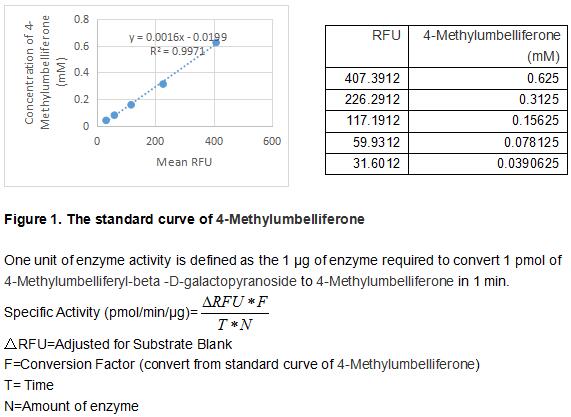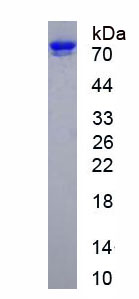Active Galactosidase Beta (GLb) 

GL-B; b-GAL; bGAL; ELNR1; EBP; GLB1; Lactase; Elastin Receptor 1,67kDa; Elastin Receptor 1(67kD); Acid Beta-Galactosidase
- UOM
- FOB US$ 212.00 US$ 530.00 US$ 1,060.00 US$ 3,180.00 US$ 7,950.00
- Quantity
Overview
Properties
- Product No.APA196Mu61
- Organism SpeciesMus musculus (Mouse) Same name, Different species.
- ApplicationsCell culture; Activity Assays.
Research use only - DownloadInstruction Manual
- CategoryEnzyme & KinaseMetabolic pathway
- Buffer FormulationPBS, pH7.4, containing 5% Trehalose.
- Traits Freeze-dried powder, Purity > 90%
- Isoelectric Point7.3
Sign into your account
Share a new citation as an author
Upload your experimental result
Review

Contact us
Please fill in the blank.
Activity test

GLB1 is a lysosomal beta -galactosidase that hydrolyzes the terminal beta -galactose from ganglioside and keratan sulfate. Defects in this gene are the causes of lysosomal storage diseases for GM1-gangliosidosis and Morquio B syndrome (also known as mucopolysaccharidosis IVB). In GM1 gangliosidosis, GM1 ganglioside accumulates in the neurons of the central nervous system, because of the deficiency of lysosomal beta -galactosidase activity. GM1 gangliosidosis demonstrates varying degrees of clinical severity but is invariably fatal, and children with the most common and severe form of GM1 gangliosidosis usually die within 3 years of birth. Morquio B syndrome patients are neurologically normal, but display severe skeletal dysostosis multiplex because of an accumulation of keratan sulfate. The activity assay of GLB1 was measured by its ability to cleave a peptide substrate, 4-Methylumbelliferyl-beta -D-galactopyranoside. The reaction was performed in 50 mM Sodium Citrate, pH 3.5 ( Assay Buffer), ainitiated by addition 50 μL of 1.5 ug/ml uPA (diluted by Assay Buffer) to 50 µL of 1.2 mM Substrate. Read at excitation and emission wavelengths of 365 nm and 445 nm (top read), respectively, in kinetic mode for 5 minutes. The specific activity of recombinant mouse GLB1 is >17000 pmol/min/µg.
Usage
Reconstitute in 10mM PBS (pH7.4) to a concentration of 0.1-1.0 mg/mL. Do not vortex.
Storage
Avoid repeated freeze/thaw cycles. Store at 2-8°C for one month. Aliquot and store at -80°C for 12 months.
Stability
The thermal stability is described by the loss rate. The loss rate was determined by accelerated thermal degradation test, that is, incubate the protein at 37°C for 48h, and no obvious degradation and precipitation were observed. The loss rate is less than 5% within the expiration date under appropriate storage condition.
Increment services
-
 BCA Protein Quantification Kit
BCA Protein Quantification Kit
-
 Molecular Mass Marker for Protein
Molecular Mass Marker for Protein
-
 Monoclonal Antibody Customized Service
Monoclonal Antibody Customized Service
-
 Polyclonal Antibody Customized Service
Polyclonal Antibody Customized Service
-
 Protein Activity Test Experiment Service
Protein Activity Test Experiment Service
-
 Electrophoretic Mobility Shift Assay (EMSA) Experiment Service
Electrophoretic Mobility Shift Assay (EMSA) Experiment Service
-
 Buffer
Buffer
-
 Lentivirus Packaging Experiment Service
Lentivirus Packaging Experiment Service
-
 Adenovirus Packaging Experiment Service
Adenovirus Packaging Experiment Service
-
 Real Time PCR Experimental Service
Real Time PCR Experimental Service
-
 Spike RBD Protein (S-RBD)
Spike RBD Protein (S-RBD)
-
 Protein G
Protein G
-
 Protein A
Protein A
Citations
- Human epidermis reconstructed from UV-B irradiated keratinocytes mimics epidermal ageingFUDISS_derivate_000000020558
- Increased permeability of reconstructed human epidermis from UVB-irradiated keratinocytes.pubmed:28034807
- Periodontal ligament cells in adolescents and adults: Genetic level responses to orthodontic forcesPubmed: 33082075
- Morphological alterations, activity, mRNA fold changes, and aging changes before and after orthodontic force application in young and adult human-derived ¡34041525







